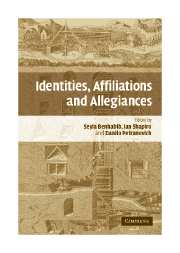Book contents
- Frontmatter
- Contents
- List of figures
- List of tables
- List of contributors
- Editors' introduction
- Part I Emergence and limits of national political identities
- Part II Multiple identities in practice: the European example
- Part III Decoupling citizenship from identity
- Part IV Identity and historical injustice
- 12 Social solidarity as a problem for cosmopolitan democracy
- 13 The continuing significance of ethnocultural identity
- 14 Amnesty or impunity? A preliminary critique of the Report of the Truth and Reconciliation Commission of South Africa
- 15 Law's races
- References
- Index
14 - Amnesty or impunity? A preliminary critique of the Report of the Truth and Reconciliation Commission of South Africa
Published online by Cambridge University Press: 05 June 2012
- Frontmatter
- Contents
- List of figures
- List of tables
- List of contributors
- Editors' introduction
- Part I Emergence and limits of national political identities
- Part II Multiple identities in practice: the European example
- Part III Decoupling citizenship from identity
- Part IV Identity and historical injustice
- 12 Social solidarity as a problem for cosmopolitan democracy
- 13 The continuing significance of ethnocultural identity
- 14 Amnesty or impunity? A preliminary critique of the Report of the Truth and Reconciliation Commission of South Africa
- 15 Law's races
- References
- Index
Summary
The Truth and Reconciliation Commission (TRC) of South Africa was the fruit of a political compromise. The terms of the compromise both made possible the Commission and set the limits within which it would work. These limits, in turn, defined the space available to the Commission to interpret its terms of reference and define its agenda. This chapter takes the compromise legislation that set up the TRC as a historical given and focuses attention on the TRC's interpretation of its terms of reference.
The TRC claimed to be different from its predecessors, whether in Latin America or Eastern Europe. It would neither grant impunity nor practice vengeance. It was committed to avoiding not one but two pitfalls: on the one hand, reconciliation turned into an unprincipled embrace of political evil and, on the other hand, a pursuit of justice so relentless as to turn into revenge. To do so, the Commission was determined to address both “victims” and “perpetrators,” not just one of these.
This double determination was first written into the interim constitution that paved the way for the legislation that set up the TRC. First, there would be no blanket amnesty. Amnesty would be conditional. It would not be a group amnesty. Every perpetrator would have to be identified individually, and would have to own up to his or her guilt – the truth – before receiving amnesty from legal prosecution.
- Type
- Chapter
- Information
- Identities, Affiliations, and Allegiances , pp. 325 - 361Publisher: Cambridge University PressPrint publication year: 2007
- 3
- Cited by

